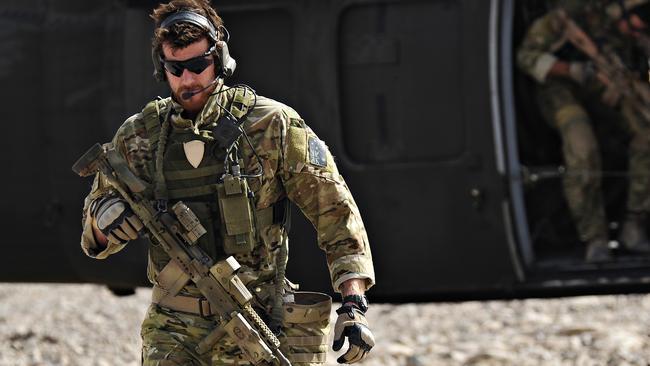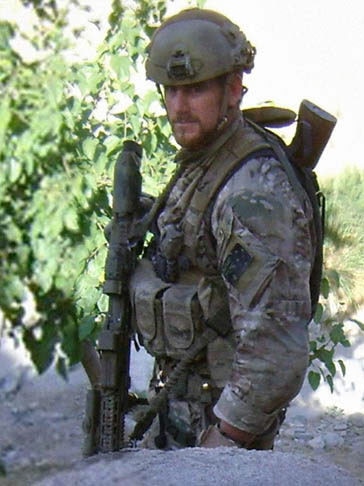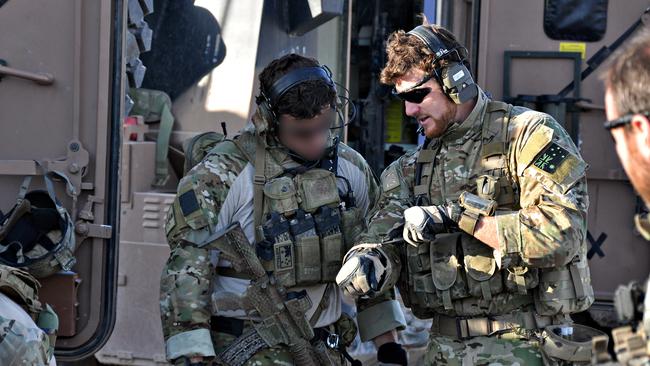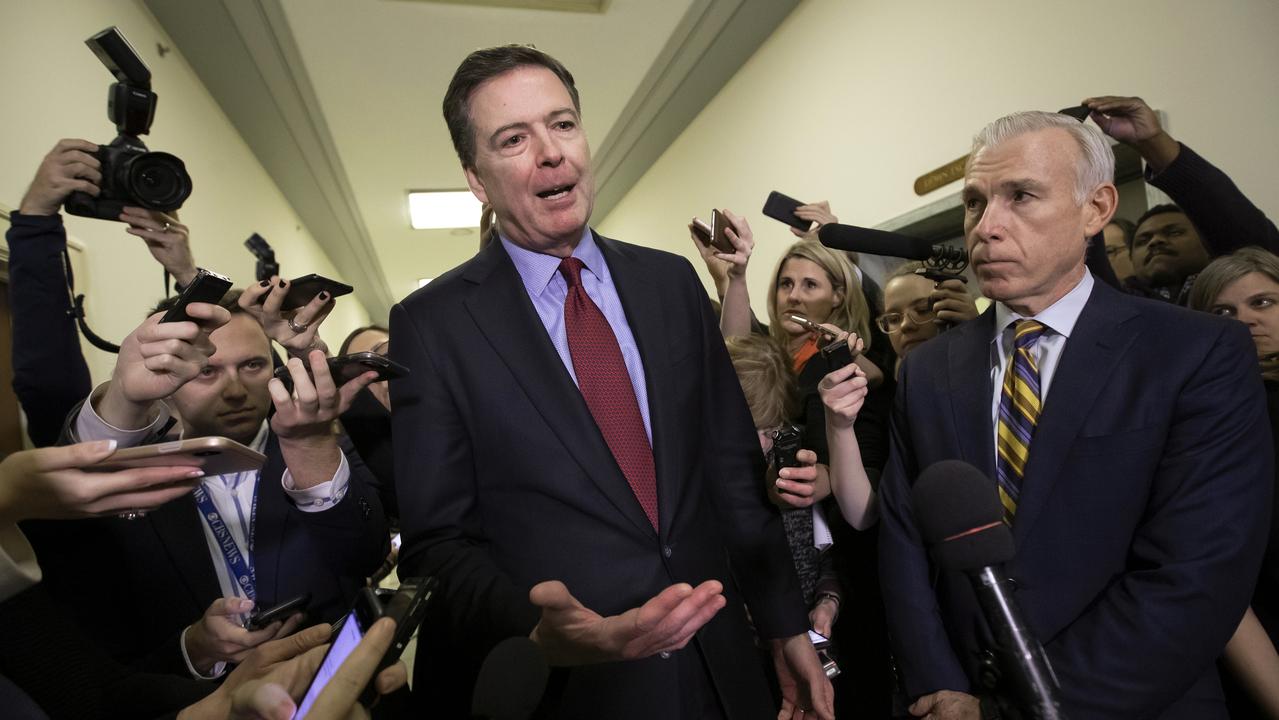Frustration at looking on led to making of hero Ben Roberts-Smith
Ben Roberts-Smith was told he’d never make a soldier. But frustration at what he saw lit a fire within him.

Corporal Ben Roberts-Smith was about a month away from the end of his fifth tour of Afghanistan at the time of his Victoria Cross action. The incident occurred in the Shah Wali Kot district of Kandahar province following an operation that began on June 10, 2010, when a commando company was sent into the Shinazef Valley to disrupt an insurgent network.
Roberts-Smith’s Special Air Service Regiment troop was on standby at Camp Russell in Tarin Kowt, awaiting the order to kill or capture enemy commanders. Early the following morning it was confirmed that a high-level target located the previous day was in Tizak, with an estimated 20 Taliban defenders in the village.
At 7.30am, 25 SASR operators and five Afghan police left Tarin Kowt in four US Black Hawk helicopters. Roberts-Smith’s patrol was in the fourth Black Hawk, providing aerial fire support to the ground assault force, as well as being the reserve assault team.
As the assault team landed it was pinned down by heavy fire. Roberts-Smith’s Black Hawk was ordered to the far end of the valley, where it was engaged from a rocky feature by insurgents armed with rocket-propelled grenades and machineguns. Roberts-Smith and another SASR sniper were sitting at the open door, firing at the insurgents as bullets tipped into the helicopter. At one point an RPG passed under Roberts-Smith’s feet as his legs dangled from the side of the Black Hawk. The insurgents eventually were killed by snipers on the opposite side of the aircraft. The helicopter then landed so the bodies could be cleared and the weapons gathered.
By this time the conditions at Tizak had not improved, and Roberts-Smith’s patrol was ordered back to the village. The helicopter, now low on fuel, landed under heavy fire and the patrol jumped out amid the dust cloud kicked up by the rotors. Roberts-Smith, the last to disembark, had not been wearing his body armour as it impeded his ability to aim his rifle; it was left behind on the aircraft.
From its position the patrol could see the exact location of one of the insurgents’ main machinegun positions. An Apache gunship attack was called in and the position was silenced, relieving some of the pressure on the initial assault force and allowing the evacuation of wounded. As the force moved off towards the target, however, it was again pinned down by enfilading machinegun fire. Grenades and another Apache strafing attack failed to silence the enemy.

After 20 minutes of this, Roberts-Smith’s commander suggested that they outflank the enemy position. While the assault force gave covering fire, the patrol swept through a nearby fig orchard in two groups: Roberts-Smith and two SASR operators on the left, with the patrol’s commander and two other operators to the right. The Australians killed an insurgent they surprised in the orchard, but were forced to ground when they came to within 80m of a mud-walled compound.
Roberts-Smith’s group managed to move within 20m of the compound before it was stopped by the sheer volume of fire. Seeing an outbuilding that could provide protection, Roberts-Smith rushed it while another operator gave covering fire. Just as he reached the building, he saw an insurgent aiming an RPG on the commander’s group. Roberts-Smith killed the insurgent through the window before the round could be fired.
With heavy fire still pouring from the compound, Roberts-Smith threw a grenade towards the enemy position with no effect. However, his actions drew the fire away from the other patrol members, allowing the commander to silence a machinegun with a grenade. In the following confusion, Roberts-Smith rushed another enemy machinegun, killing its operator, before moving along the wall and killing the operator of the gun pinning down the initial assault force. The patrol was joined by that force, and after further heavy fighting the village was cleared.
Roberts-Smith narrowly escaped becoming a fatality that day. During the mopping up, he and another team member were acting as scouts when Roberts-Smith was fired on by an insurgent jumping out from behind some nearby rocks. Somehow the bullets missed, and the insurgent was killed by the second scout. Asked about this later, Roberts-Smith put the incident down to sheer luck.
By the end of the fighting more than 70 insurgents were dead, including significant commanders. Roberts-Smith was credited with being instrumental in the success of the attack, a statement with which he later disagreed.
“I was awarded the Victoria Cross for my part in the battle, but others were equally deserving that day,” he says. “Nobody knows what they did, so it’s up to me as the one in the public eye to speak for them.”
The fighting at Tizak was part of a broader offensive fought in May and June 2010 in the Shah Wali Kot district. For their actions during this period, both SASR and the 2nd Commando Regiment were awarded the first battle honour since the end of the Vietnam War.
Roberts-Smith was once told by a teacher that he would never make a soldier. Years later the two met again, and the teacher admitted with a grin that he might have been wrong.

Roberts-Smith was born in Perth on November 1, 1978, the son of Major General Len and Sue Roberts-Smith, and attended the Hale School. As a boy he could have been a more diligent student but there was never any doubt in his mind that he would be a soldier. Family members had served in the armed forces since the Boer War, including three who had landed on Gallipoli on April 25, 1915. In 1996 the 17-year-old joined the Australian regular army straight from school.
Following training, Roberts-Smith was posted to the 3rd Battalion, Royal Australian Regiment, with whom he was deployed twice to Malaysia and on two operational tours of East Timor. There he witnessed SASR soldiers inserted into action by helicopter while he watched, frustrated, from the sidelines. At that moment he decided that he would join the SASR or leave the army.
In 2003 Roberts-Smith completed the SASR selection course and deployed to Fiji and Iraq before his first tour to Afghanistan in 2006. In that first tour he was awarded the Medal for Gallantry for his actions as a patrol sniper and scout at a remote observation post in the Chora Valley of Oruzgan province. The post was subjected to several enemy attacks, and on several occasions Roberts-Smith moved to exposed positions to deal with the threats.
In 2007 Roberts-Smith was rocked by the death of his friend, mentor and “the bravest man I ever knew”, fellow SASR operator Sergeant Matthew Locke, who was killed in action in Afghanistan on October 25. Locke had been awarded the Medal of Gallantry in the same action as Roberts-Smith in 2006. On January 23, 2011, Roberts-Smith was invested with the Victoria Cross by governor-general Quentin Bryce in Perth.
Back in 1998 Ben had met Emma Groom at a wet and muddy Kapyong Day Ball at Holsworthy Barracks in Sydney. Emma came from a proud military family but was determined not to become involved with a soldier. Nevertheless, they were married at the University of Western Australia on December 6, 2003, and in 2010 welcomed twin daughters, Eve and Elizabeth. Her husband’s work was a source of tension and worry for Emma, reinforced with each deployment by the request that he update his will. That anxiety grew when another friend, Sergeant Blaine Diddams, was killed in action three days into Roberts-Smith’s sixth and final tour of Afghanistan in 2012.

During this last tour Roberts-Smith headed more than 50 high-risk operations. On October 21 he led six SASR operators, a signaller and an interpreter on foot on a lone reconnaissance patrol deep into the Taliban stronghold of Char-Chine to locate an enemy commander. At first light the patrol set an ambush and killed two insurgents before coming under fire. The patrol was outnumbered and surrounded by a field of improvised explosive devices, with only two possible routes of escape. Decisions made by Roberts-Smith during this period made possible the patrol’s escape, and the intelligence gathered on the mission led to the killing of the insurgent commander. For his actions during this period he was awarded the Commendation for Distinguished Service. According to his citation, his actions “reflected his dedication to duty and martial skill, and epitomised the regimental motto ‘Who Dares Wins’ ”.
A week after arriving back from Afghanistan in late 2012, Roberts-Smith walked into the almost deserted Campbell Barracks in Swanbourne, Perth, and handed in his gear, effectively leaving the army. As patrol commander he had achieved his final goal and was looking towards a more secure future for his family.
Extract from For Valour: Australians Awarded the Victoria Cross by Craig Blanch and Aaron Pegram for the Australian War Memorial, published by NewSouth Publishing ($79.99), available November 1.




To join the conversation, please log in. Don't have an account? Register
Join the conversation, you are commenting as Logout